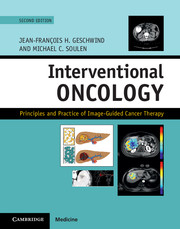Book contents
- Frontmatter
- Contents
- List of contributors
- Section I Principles of oncology
- Section II Principles of image-guided therapies
- 2 Principles of radiofrequency and microwave tumor ablation
- 3 Principles of irreversible electroporation
- 4 Principles of high-intensity focused ultrasound
- 5 Principles of tumor embolotherapy and chemoembolization
- 6 Principles of radioembolization
- 7 Principles of intra-arterial infusional chemotherapy in the treatment of liver metastases from colorectal cancer
- 8 Imaging in interventional oncology: Role of image guidance
- 9 Novel developments in MR assessment of treatment response after locoregional therapy
- Section III Organ-specific cancers – primary liver cancers
- Section IV Organ-specific cancers – liver metastases
- Section V Organ-specific cancers – extrahepatic biliary cancer
- Section VI Organ-specific cancers – renal cell carcinoma
- Section VII Organ-specific cancers – chest
- Section VIII Organ-specific cancers – musculoskeletal
- Section IX Organ-specific cancers – prostate
- Section X Specialized interventional techniques in cancer care
- Index
- References
6 - Principles of radioembolization
from Section II - Principles of image-guided therapies
Published online by Cambridge University Press: 05 September 2016
- Frontmatter
- Contents
- List of contributors
- Section I Principles of oncology
- Section II Principles of image-guided therapies
- 2 Principles of radiofrequency and microwave tumor ablation
- 3 Principles of irreversible electroporation
- 4 Principles of high-intensity focused ultrasound
- 5 Principles of tumor embolotherapy and chemoembolization
- 6 Principles of radioembolization
- 7 Principles of intra-arterial infusional chemotherapy in the treatment of liver metastases from colorectal cancer
- 8 Imaging in interventional oncology: Role of image guidance
- 9 Novel developments in MR assessment of treatment response after locoregional therapy
- Section III Organ-specific cancers – primary liver cancers
- Section IV Organ-specific cancers – liver metastases
- Section V Organ-specific cancers – extrahepatic biliary cancer
- Section VI Organ-specific cancers – renal cell carcinoma
- Section VII Organ-specific cancers – chest
- Section VIII Organ-specific cancers – musculoskeletal
- Section IX Organ-specific cancers – prostate
- Section X Specialized interventional techniques in cancer care
- Index
- References
Summary
Introduction
Radioembolization is defined as the administration of micron-sized embolic particles loaded with a radionuclide using percutaneous transarterial techniques. Fluoroscopic guidance, angiographic endpoints of embolization and stasis, and the need to modify this based on angiographic findings makes this treatment a true embolization procedure. Dosimetry planning, the administration and delivery of radiation on the microscopic level, the modification of the dose based on tumor and hepatic volume, in addition to the required knowledge of radiation effects on tissue make this a brachytherapy procedure. Radioembolization therefore combines radiation with embolization.
Investigations into yttrium-90 (90Y) and other radionuclides as part of a microsphere or particle for the treatment of cancer date back to the 1960s. Initial studies of resin 90Y in humans were reported in the late 1970s. The seminal work in a canine liver model demonstrating the safety and feasibility of using 90Y therapy for hepatic malignancies was reported in the late 1980s. Human studies of 90Y microsphere therapy in liver applications followed from the late 1980s through to the 1990s. These investigations established the safety of 90Y for intrahepatic applications as well as the tolerance of normal parenchyma to radioembolization. It should be noted that different disciplines use slightly different names for radioembolization: microsphere brachytherapy, microbrachytherapy, hepatic intra-arterial radiotherapy, and selective internal radiation therapy. The term radioembolization will be used in this chapter, as it is the preferred term per Society of Interventional Radiology standards document.
Mechanism of radioembolization
Radioembolization of liver tumor takes advantage of the unique vascular system of the liver. In normal liver tissue, approximately 70–80% of the organ's blood flow is supplied by the portal vein, and the hepatic artery accounts for the rest. This contrasts with both hepatocellular carcinoma (HCC) and metastatic tumors to the liver, which have approximately 80–100% of their blood flow supplied by the hepatic artery. This difference in perfusion is exploited by radioembolization, whereby radioactive microspheres doped with a radionuclide are used to produce intentional microembolization of the tumor capillary bed in the liver tumor(s) by delivering the microspheres through the hepatic artery and, subsequently, selectively targeting malignant disease.
- Type
- Chapter
- Information
- Interventional OncologyPrinciples and Practice of Image-Guided Cancer Therapy, pp. 44 - 51Publisher: Cambridge University PressPrint publication year: 2016



